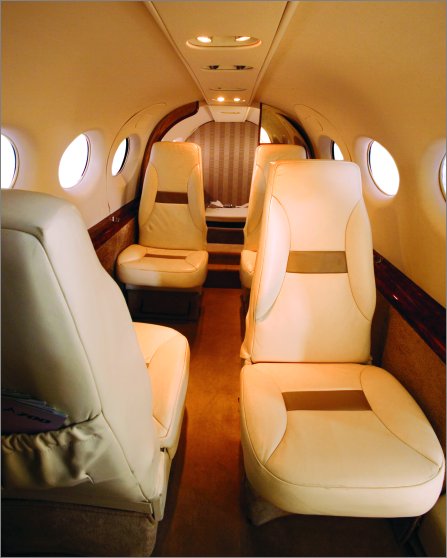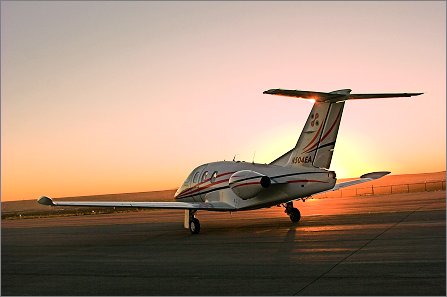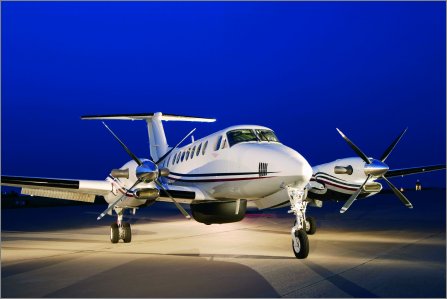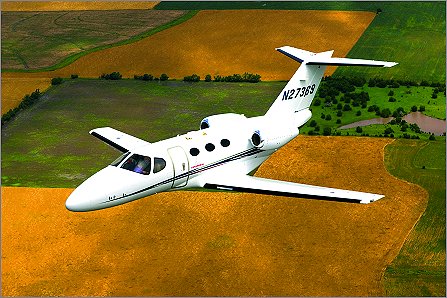KATE SARSFIELD / LONDON
Very light jets promise to kickstart a new sector of air taxis that could revolutionise business travel in the USA. Can they do the same for Europe?
Very light jets (VLJ), personal jets, micro jets, Barbie jets – the name tags are as plentiful as the numbers of these new models of small aircraft under development. Over the next 12 months the first three VLJs in what is forecast to be a bustling market sector will enter service – and if countless industry predictions are borne out, they are set to revolutionise personal transport for millions of travellers across the globe by making private jet travel accessible to a mass market for the first time.
 |
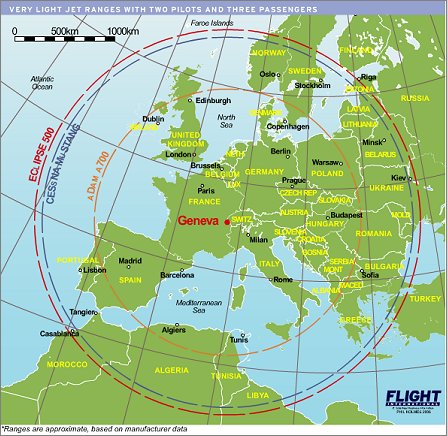 |
© Flight International
|
Eclipse Aviation is expected to be first off the mark in Europe, with initial deliveries of its five-seat Eclipse 500 scheduled for the first half of 2007. Cessna has earmarked the fourth quarter of next year for Europe’s first six seat-Citation Mustang delivery, with Adam Aircraft following hot on its heels with its eight-seat A700.
Within Europe’s business aircraft operating community, the VLJ is being greeted with a mixture of excitement, curiosity, apprehension and scepticism. The continent is home to the world’s second-largest business aviation fleet, with over 2,000 turbine-powered aircraft alone, and boasts a thriving and competitive charter industry, where the bulk of the demand is for light- to medium-size business jets. “Around 600 aircraft are available for charter in Europe, which account for annual revenues of approximately £800 million [$1.4 billion],” says Neil Harvey, manager for executive aviation for international charter broker Hunt and Palmer.
Discerning customers
Harvey says European charter customers are discerning, and expect certain standards from the aircraft they hire. “The focus has switched in the last few years from piston twins and turboprops in favour of jets,” he says. “While the smaller cabin of the typical VLJ may be adequate for certain markets, for many established customers size of the cabin is very important, particularly on routes of over 2h,” he says. The VLJ could find it hard to compete against established light jets such as the Citation Bravo and the Hawker 400XP on similar routes. “Passengers may find it uncomfortable to have four other people, for example, in such close proximity,” Harvey says.
This theory is strongly refuted by the VLJ manufacturers, which cite the size of their orderbooks as a strong indication of the aircraft’s value to charter operators. Eclipse has orders for over 2,500 Eclipse 500s, with more than 60% of them from charter companies. The balance is split equally, the company says, between corporate customers and owner-operators. Adam has booked orders for nearly 300 A700s to date, with 225 fleet/charter sales and around 15% of its total orderbook for European customers.
Cessna has recorded over 240 orders for its Mustang, and although the company will not disclose a market sector breakdown, it stresses that the $2.4 million aircraft is becoming a popular choice for charter companies, particularly in Europe, which represents 30% of Mustang sales. Cessna’s largest European customer, UK-based business aircraft charter company London Executive Aviation (LEA) has seven Mustangs on order, with the first aircraft earmarked for delivery in the last quarter of 2007. LEA, which also has an Eclipse 500 on order, is an outspoken proponent of VLJ-based charter services and is seeking finance to purchase a further 25 Mustangs to support a new internet-based on-demand charter service.
|
| VLJ cabins are too small, say critics of per-seat on demand charter |
|
| The Eclipse 500 looks set to be the first VLJ in Europe |
|
| Charter customers tend to prefer jets over turboprops like these Beechcraft, King Air operators say |
|
| Cessna expects to deliver six Citation Mustangs to Europe next year |
|
“The VLJ will inevitably replace the Beechcraft King Airs and piston twins, such as the Piper Seneca and Navajo,” says LEA chief executive Patrick Margetson-Rushmore. “Although the Mustang will cost around the same to operate as the King Air, it is a very modern machine and in our experience customers will always choose a jet over a turboprop.”
Like Harvey, Margetson-Rushmore suggests that some travellers who are familiar with the larger cabin of the Bravo, and the super light Citation XLS, for example, are unlikely to switch to the smaller VLJ. “There will always be a bracket of people with high disposable incomes, or who within the company hierarchy do not need to justify the expense of a larger-cabin aircraft,” he says. Yet the VLJ, with both its low utilisation costs and price tag, will have huge appeal, he adds.
Cessna’s entry-level Citation CJ1+, the nearest to the VLJ in terms of cabin size, is priced at more than $4.2 million and the aircraft’s direct operating costs are around $700 an hour compared with around $450 for the Mustang, $470 for the A700 and $350 for the Eclipse 500. “The VLJ will have enormous appeal to those cost-and- time conscious individuals and middle managers for whom chartering is an unrealistic dream,” says Margetson-Rushmore.
Margetson-Rushmore and Harvey suggest the VLJ will open up new markets and lower the barrier to entry into business aviation, simulating the role played by fractional ownership in the 1990s in the USA and latterly in Europe. Fractional pioneer and market leader NetJets claims that around 80% of its customers are new to business aviation, and VLJ airframers and operators and confident the market will undergo another major shake-up as the benefits of VLJ-based travel are realised.
European challenge
VLJ airframers have until now concentrated much of their efforts on the US market, as acceptance there is vital to the success of these programmes.
Eclipse concedes Europe has played second fiddle to its largest market and currently only accounts for 7% of its total orderbook. “We don’t have our feet on the ground in Europe yet as we have had to be laser-focused on what we spend our money on,” says Eclipse chairman and chief executive Vern Raburn. “We plan to significantly increase our investment in marketing and sales support in the next quarter, but realistically we cannot begin to deliver new aircraft until 2008.”
Raburn says that Europe does pose challenges, but the continent’s operators are ready to embrace VLJs. He says: “It is not a tough market to crack, just different. Europe [with 25 countries in the European Union alone] is not homogenised like the USA and corporate aviation is not as broadly accepted, as Europeans are not ostentatious by nature,” he says. “The Eclipse 500 will break that cultural logjam and could reveal a vast untapped market,” he adds. Raburn says the Eclipse 500 is pragmatic, economical and will be the quietest aircraft on the market when it enters service.
Adam ambition
Joe Walker, president of Adam Aircraft, says Europe is the company’s second largest market outside North America, accounting so far for 45 of its 300 sales. “The typical fleet size of a country follows its gross national product, with Germany, France and the UK set to be our largest markets,” he says. Like Eclipse, Adam is planning to establish a sales and distribution network throughout the region to support its customers, and Walker believes there will be a higher demand for the $2.25 million A700 from the charter community. “The aircraft’s cabin will house six revenue seats and two pilots for half the price of a CJ1,” Walker says. The aircraft has a range of over 1,300km (720nm) with two pilots and three passengers.
Cessna has made a number of Mustang sales to charter operators throughout Europe, including Italy, Spain, Germany – which is home to the largest Citation fleet in Europe – and the UK. The aircraft has a range of 1,850km carrying two pilots and three passengers, with IFR reserves – “ideal for short hops of around 1.5-2h – London-Milan, for example”, says Trevor Esling, Cessna’s European sales director.
Point to point
Cessna’s largest European Mustang customer, LEA, says the charter market is evolving in Europe to meet the different demands of customers who are demanding point-to-point air travel to bypass the congested airline hub system, gridlocked road networks and inefficient train services, particularly in the UK.
“Time saving is the critical issue for business travellers. To make this type of operation work you have to match their requirements,” says Margetson-Rushmore.
That is one reason behind LEA’s plans for internet-based on-demand service using the Mustangs. LEA says it may focus on the UK market initially, establishing services to key destinations, including Bristol and Oxford and Cambridge, that will be “very” competitively priced.
Richard Noble, entrepreneur and pioneer of the Farnborough FI single-engined turboprop-based air-taxi concept, argues that the UK is well placed to benefit from regular on-demand charter services, given the existence of 200 “public use” airfields and more than 150 private and military strips, many of which see little day-to-day activity. “There are huge investments in transport infrastructure at the moment in road, rail and commercial airline activity. Staring at us is a major infrastructure that is heavily under-used,” he says.
For Margetson-Rushmore, the success of the operation is dependent on establishing “a large and sustainable aircraft fleet and a level of service that is both consistent and efficient”. Eclipse’s Raburn agrees: “Eclipse’s real competitors are cars, and in Europe the train system is also very efficient.” However, he believes that VLJs in the hands of charter companies can change and re-invigorate the way Europeans travel on business, making “day trips between cities poorly connected by scheduled airline services possible”.
This vision has been embraced by Eclipse’s largest customer DayJet. With orders and options for 239 and 70 Eclipse 500s, respectively, the Florida-based start-up is set to launch, in the south-east USA in the fourth quarter, the first “per-seat” on-demand charter for short-haul regional travel – 300-600km. The company is planning to launch a similar service in Europe, “once it has ironed out the kinks in the programme and has built enough critical mass to support the venture”.
“This new category of transport will redefine the total cost of travel – both in time and money,” says DayJet chief executive Ed Iacobucci, who wants to revolutionise business travel for the middle manager who, primarily, wants to travel between small towns. The aim is to allow users to book online with preferred departure and arrival times and allow passengers to complete their business in a day rather than the two or more days that using a car requires. Customers will get lower fares by having a more flexible travel window – the time between when a customer is willing to show up at the arrival airport and when the flight must leave to make it to the destination airport at the requested time.
Iacobucci, founder of software maker Citrix Systems, says the DayJet concept was inspired after discovering the convenience that comes with owning a private jet. “I want to extend the comfort and experience level to far more people than ever before. Business aircraft charter has been dominated for far too long by the C-Suite – chief executives and chief operating officers, for example. The magic of the VLJ is that it will open up this market to so many more people,” he says.
Iacobucci says the seat price will be comparable to a non-discounted airline ticket plus the cost of an overnight stay, or about 25% more. Customers will only pay for their seats, not for use of the entire aircraft as they would for a charter. DayJet says it will carry a maximum of three passengers in aircraft piloted by two crew, and has calculated a break-even point of 1.3 passengers per flight. The company has also developed a state of-the-art software system to manage flight reservations and aircraft scheduling “to maximise utilisation”.
Iacobucci says the programme could be transferable to most world regions. “There are no geographic boundaries to the core transport values. The DayJet concept could easily be adapted to Europe and we will look at this region in around two years.”
Sceptical stance
Opponents of the per-seat on demand charter concept are sceptical. “While it is one thing chartering an aircraft for yourself and a couple of colleagues, it is quite another travelling in a small cabin with people you have never met,” says Hunt and Palmer’s Harvey. Rob Dranitzke, business development manager for Netjets Europe, agrees: “That concept will not catch on. Business jets are a productivity tool where passengers need the time and space to work or hold meetings.”
Iacabucci disagrees. “We asked a number of customers to sit in a mock-up of an aircraft, which seats two pilots and three forward-facing passengers. Eighty-five per cent of those surveyed said they would be very interested in the service.”
Raburn also dismisses the critics of the Eclipse cabin. “These assumptions are just based on anecdotal evidence,” he says. “Customers are far more cost sensitive than operators give them credit for. Our demonstrator has flown over 550h and the persistent comment from passengers is that the cabin is really comfortable.”
Like Iacobucci, a number of entrepreneurs have talked of starting air-taxi operations or expanding the availability and use of charter flights, including Pogo Jet – a venture backed by Robert Crandall, former chairman and chief executive of American Airlines – which has ordered 75 Adam A700s, and Eclipse 500-based charter programme Linear Jet. It remains to be seen, however, if the ranks of European operators embrace the concept on the same scale. Virgin Group chairman Richard Branson is known to be considering a charter service using Eclipse 500s, and if the go-ahead is given this would boost the credibility of these operations in Europe overnight. Similarly, NetJets Europe says it will wait until the VLJs have entered service to gauge the true operational value of these aircraft and see “if these aircraft can serve a business need in Europe”.
The success of VLJ charter operations hinges on changing customer perception of private jet travel, particularly in small aircraft, and luring business passengers from airlines and other modes of transport. Adam Aircraft’s Walker anticipates that VLJ-based on-demand charter will compound the problems facing airlines by siphoning off even more business travellers, who purchase the high-priced tickets that airlines count on for the bulk of their profits.
Aviation analyst Richard Aboulafia sounds a note of caution, however. “Take a moment to consider the charter customer, that oddest of ducks,” he says. “He has more travel cash than an airline passenger, but not enough to be in a real business jet. Nor does he have enough to buy into a jet card programme or to use existing air charter operators. He doesn’t want or need to fly more than 2h/1,000 miles at a time. And you need enough of him in enough markets to avoid a high percentage of deadhead flights, but not too many of him in these markets to justify a decent airline service. These plans won’t work with just any old aircraft. Never mind that you could prove the concept using thousands of depreciated, low-cost, service-tested aircraft. You apparently need a new VLJ to make air taxi magic happen. And of course you need enough enthusiastic investors to turn these unfunded air taxi plans into reality. VLJs might help a few new charter operators to make cash, but we’re talking a few score aircraft, not thousands.”
Source: Flight International





















